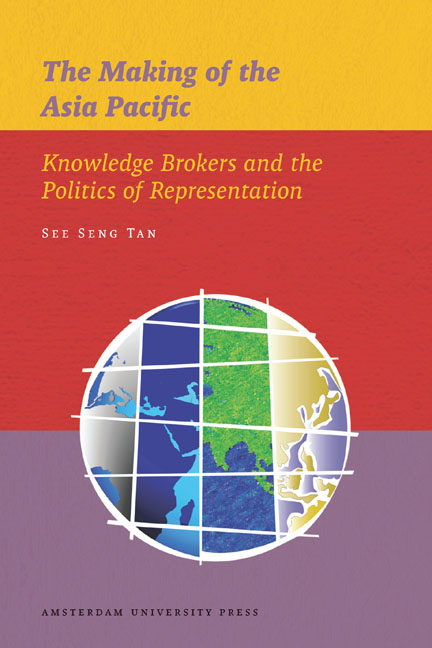Book contents
- Frontmatter
- Dedication
- Contents
- List of Tables
- Acknowledgements
- 1 Introduction: From ‘Pacific Asia’ to ‘Asia Pacific’
- 2 The Desire for Essence
- 3 Knowledge Networks as Agents of Representation
- 4 Representing the ‘Asia Pacific’
- 5 Representing Sovereign States
- 6 Representing the ‘In/Human’ Faces of Asia Pacific Security
- 7 Representing the ‘Authority’ of Knowledge Networks
- 8 Conclusion: A Plea in Three Parts
- Notes
- Bibliography
- Index
- Miscellaneous Ensmatter
4 - Representing the ‘Asia Pacific’
Published online by Cambridge University Press: 10 December 2020
- Frontmatter
- Dedication
- Contents
- List of Tables
- Acknowledgements
- 1 Introduction: From ‘Pacific Asia’ to ‘Asia Pacific’
- 2 The Desire for Essence
- 3 Knowledge Networks as Agents of Representation
- 4 Representing the ‘Asia Pacific’
- 5 Representing Sovereign States
- 6 Representing the ‘In/Human’ Faces of Asia Pacific Security
- 7 Representing the ‘Authority’ of Knowledge Networks
- 8 Conclusion: A Plea in Three Parts
- Notes
- Bibliography
- Index
- Miscellaneous Ensmatter
Summary
What goes for production and disciplining of social spaces goes also for the production and disciplining of subjects. From a genealogical standpoint, there are no subjects, no fully formed identical egos, having an existence prior to practice and then implicated in power political struggles. Like fields of practice, subjects emerge in history. (Ashley 1987a: 410)
The regional idea of the ‘Asia Pacific’, which arguably furnished its East/Pacific Asian proponents and purveyors with a cultural and political reach well beyond their region's geographical limits, gained currency during the 1980s and enjoyed wide legitimacy especially during the 1990s. Following the 1993-1998 financial crisis that blighted East Asia, the consequent establishment in 1999 of the ASEAN Plus Three (APT) institution comprising China, Japan, South Korea and the ten ASEAN countries, regional perturbations over the apparent lack of solidarity and support shown by the United States (and USled international financial institutions) in response to East Asia's plight during the financial crisis (Beeson & Islam 2005), and a propensity among North America-based analysts to use ‘Asian security’ rather than ‘Asia Pacific security’ as the preferred reference (Alagappa 1998, 2003; Simon 2001), the Asia Pacific idea has since waned somewhat in the face of stiff competition from competing regional visions and their supporting institutional architectures, specifically ‘East Asian’ regionalism (Camilleri 2005; Hund 2003; Stubbs 2002). But it has by no means gone away, not least because the label has been institutionalised in the names of regional organisations such as the Asia Pacific Economic Cooperation – that is, APEC – and visions such as the Free Trade Area of the Asia Pacific (FTAAP), which emerged in the wake of the faltering Doha Round of world trade talks (Morrison & Pedrosa 2007). In a crucial sense, the persistence and prevalence of the Asia Pacific idea have partly been the consequence of what Ashley (in the above epigraph) has referred to as the productive and disciplinary effects of not only social spaces – the ‘Asia Pacific’ being the imagined geopolitical/economic space in question here – but also the subjects, state and non-state ‘actors’, that ostensibly and ‘legitimately’ inhabit such spaces.
- Type
- Chapter
- Information
- The Making of the Asia PacificKnowledge Brokers and the Politics of Representation, pp. 69 - 110Publisher: Amsterdam University PressPrint publication year: 2013
- 1
- Cited by



